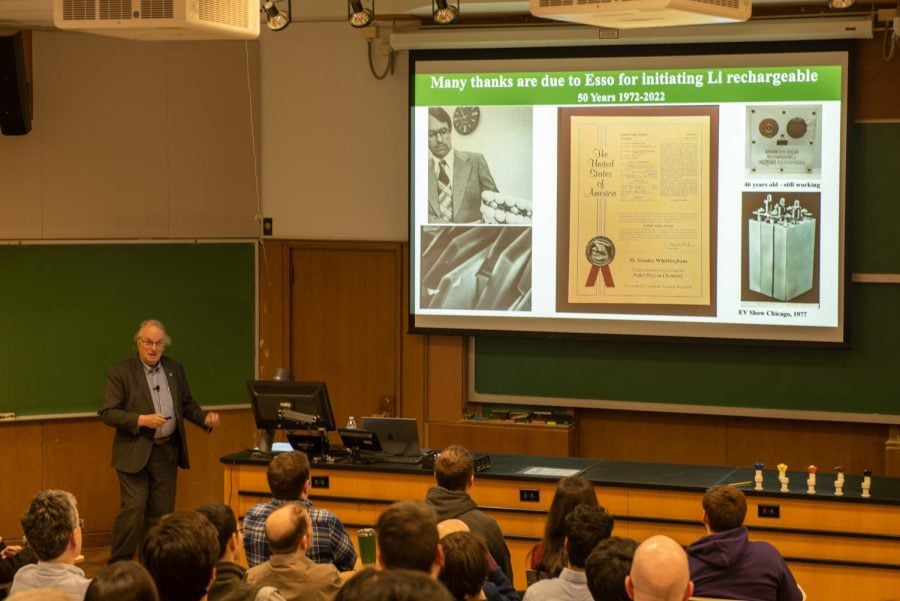Nobel Prize in Chemistry recipient speaks at annual John E. Dorn Lecture
Jay Dugar/Daily Senior Staffer
Stanley Whittingham presents a slide thanking Esso, a trading name for ExxonMobil, for its corporate lab contribution to the development of lithium-ion batteries.
May 4, 2023
Stanley Whittingham, the 2019 Nobel laureate in chemistry, spoke on the sustainable future of lithium-ion batteries — which are used in devices ranging from mobile phones to electric vehicles — at the McCormick School of Engineering’s 50th annual John E. Dorn Lecture on Tuesday. He emphasized the importance of creating a lithium battery industry in America.
The lecture, sponsored by the materials science and engineering department, was established to honor John Dorn (Weinberg ’31, ’32), an alumnus who helped NU create one of the U.S.’ first material research centers at the turn of the 1960s. The speaker is selected in a vote by the department’s faculty.
McCormick Prof. Mark Hersam, who hosted the lecture, said Whittingham won the vote to be this year’s speaker because of his seminal contributions to the development of the rechargeable lithium-ion battery.
Whittingham developed and commercialized lithium-ion batteries while working at ExxonMobil, one of the world’s largest energy companies, in the 1970s. Hersam said the batteries now hold the potential for large-scale renewable energy and could eventually help electrify transportation vehicles, including electric trucks and planes.
“Stan has had tremendous impact. (He) revolutionized communication, revolutionized electronics, particularly portable electronics, and revolutionized transportation with the advent of electric vehicles,” Hersam said. “I would contend that his work has the potential (to) lead to renewable energy taking over the grid.”
Whittingham began his remarks by discussing battery industry progress over the past 50 years. In the 1970s, his group was the first to identify electrode materials, which allow lithium ions to move back and forth between cathodes and anodes and produce electrical energy.
Whittingham said the industry is currently working toward removing cobalt — which is expensive, toxic and has been mined illegally, causing child labor issues in the Congo — from batteries.
He said the industry is also focused on increasing the energy density in battery cells. Today’s battery cells max out at 25% of their theoretical energy densities, which means they store a quarter of the energy per unit volume that could theoretically be collected in a battery. However, increasing the energy density could mean batteries become much more volatile and thermally unstable, rendering them unsafe for commercial use, Whittingham said.
“There’s still huge opportunities to increase the energy density, to do much more materials research to make these fields better,” Whittingham said. “We’ve found that all these (electrochemical) batteries lose somewhere between 10 and 15% capacity in their very first cycle. Our challenge now is if we can modify the material so it’s not diffusion-limited.”
He said engineers could try to limit the reactivity of more energy-dense compounds by reducing them to single crystals, which have minimal surface area. But, this approach wouldn’t generate much power, so it needs to be coupled with surface treatments, he added. Surface treatments involve modifying the material to be less reactive across its surface.
Hersam, director of Northwestern’s Materials Research Center, said while renewable energy technologies like wind and solar power are cost-competitive with fossil fuels, they aren’t consistent enough to keep up with energy demand.
“For renewable energy technologies to completely take over the grid, large-scale energy storage technologies are needed,” Hersam said. “Lithium-ion batteries are one of the leading candidates for grid-level storage, and thus are critical to a full transition to clean energy.”
Ismael Coello, a second-year Ph.D. candidate in materials science and engineering, said he was inspired by listening to the former Nobel laureate and learning more about the current electric energy market.
“There’s definitely still more work to do in the field,” Coello said. “(Whittingham’s work) is still very relevant to the questions we’re asking today about the energy sector.”
Whittingham also spoke on the need to produce battery materials in the U.S., arguing there are security and sustainability concerns with depending on an overly globalized supply chain.
Rather than having materials travel 50,000 miles, Whittingham said he hopes to change this by leading Battery-NY under New Energy New York. He is the vice chair of research at Battery-NY, which was granted nearly $114 million in federal and state funding in September.
“Every battery you can think of in commercial use today has gone through China,” Whittingham said. “We lose all the manufacturing. We’re going to convince American equipment manufacturers to come in and make equipment to make batteries and ideally make them differently.”
Hersam said over the next five or 10 years, lithium-ion batteries are likely to see longer lifetimes and higher energy and power densities, paving the way for larger next-generation electric applications supporting a transition away from fossil fuels.
Email: noracollins2025@u.northwestern.edu
Twitter: @noracollins02
Related Stories:
— Northwestern honors seven professors with annual Teaching Award
— Alumni Christina Kosmowski, Rodney Priestley to speak at 2023 McCormick graduation events



